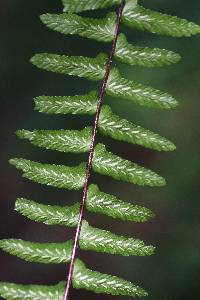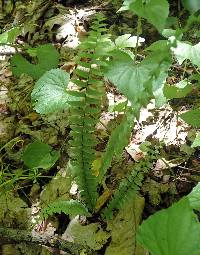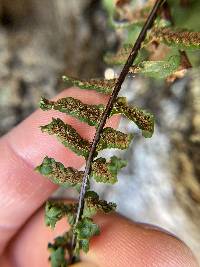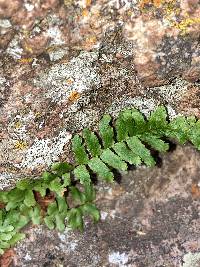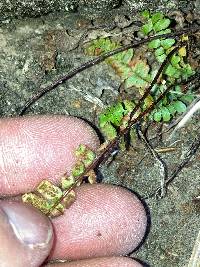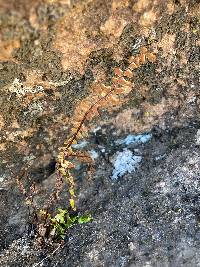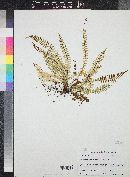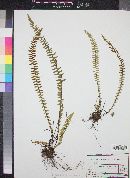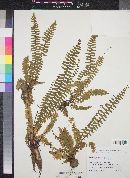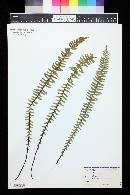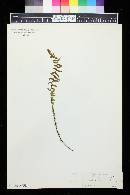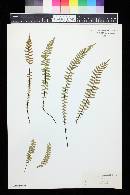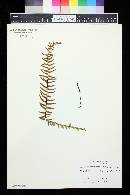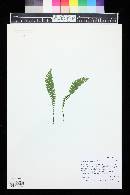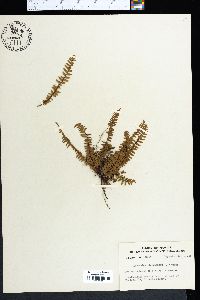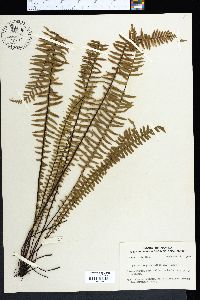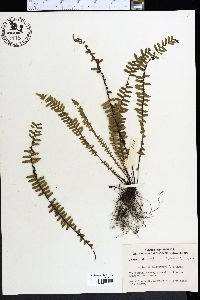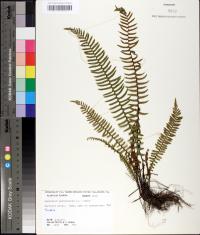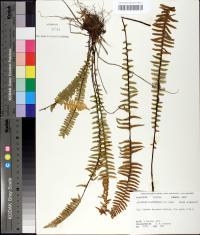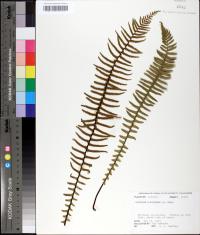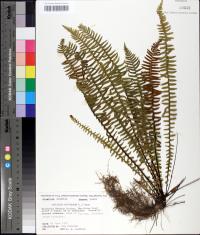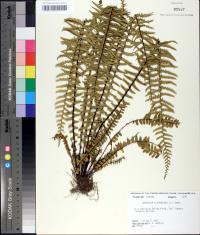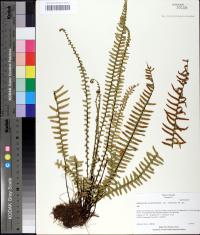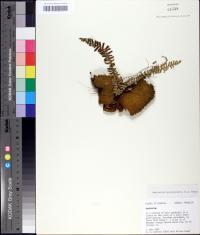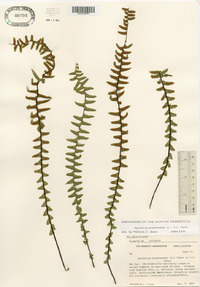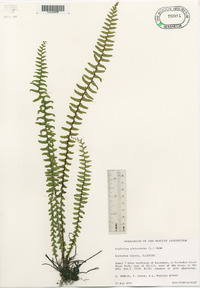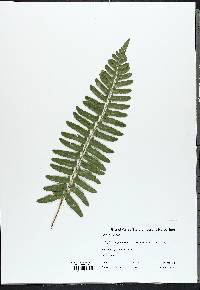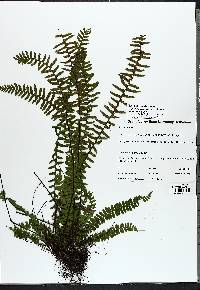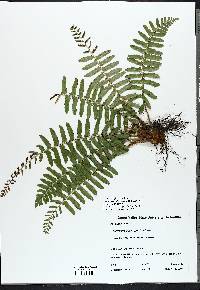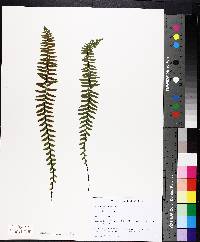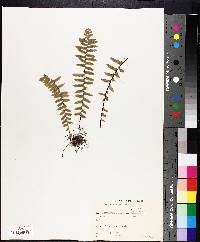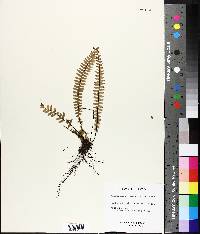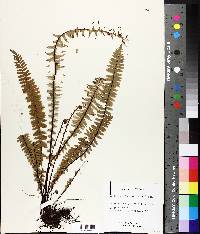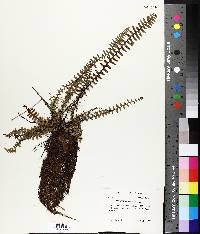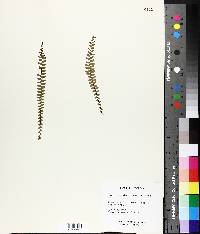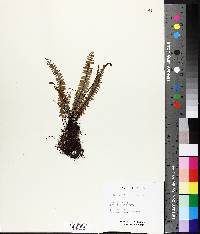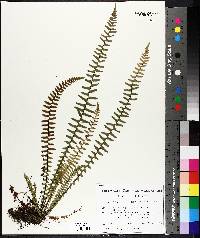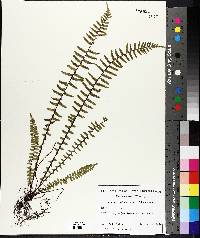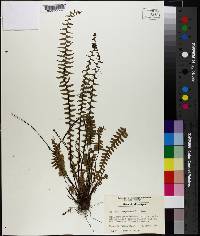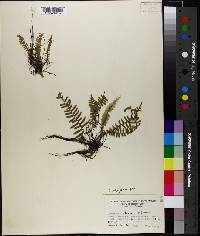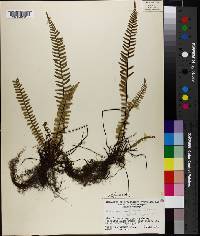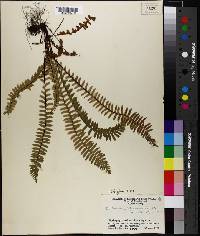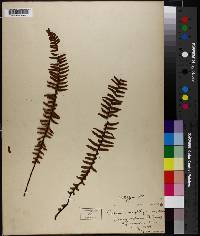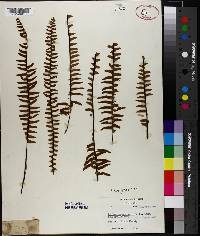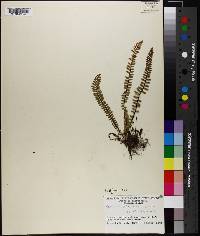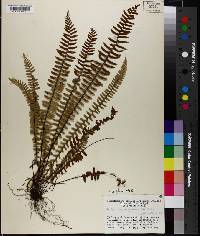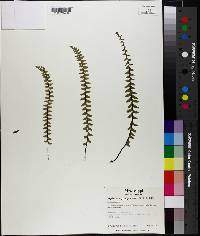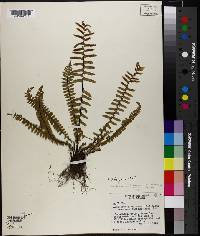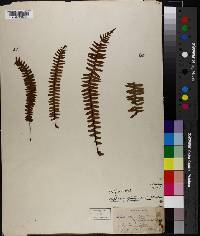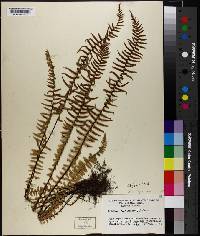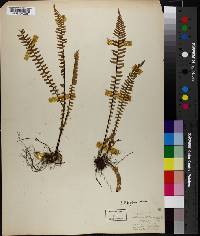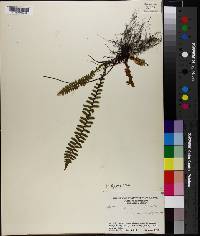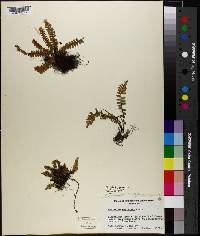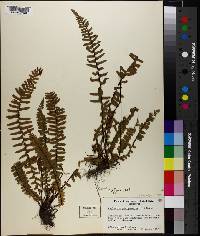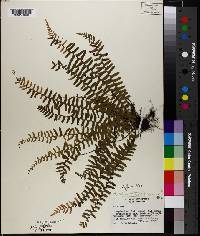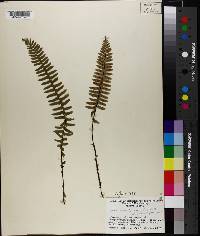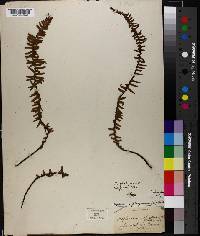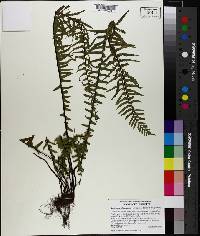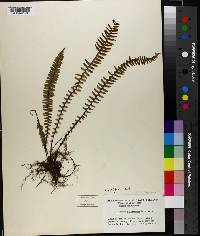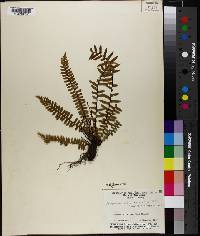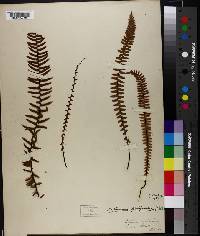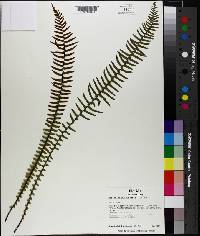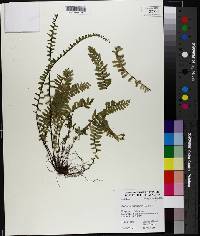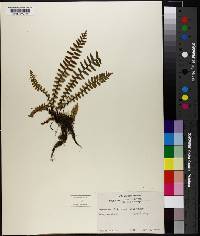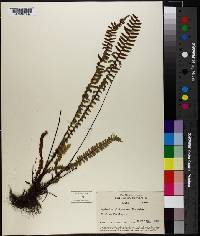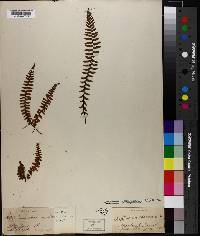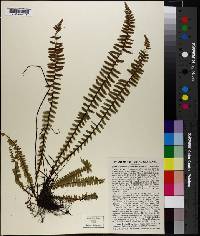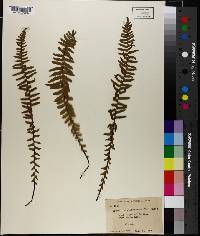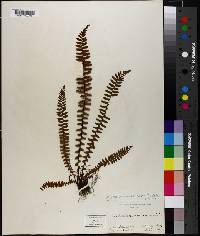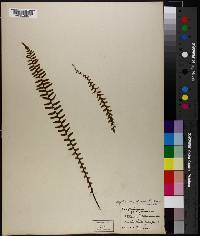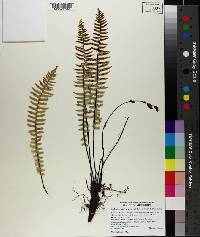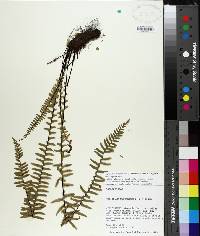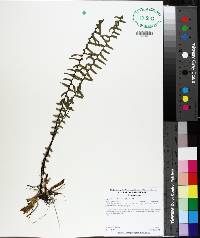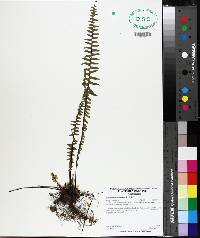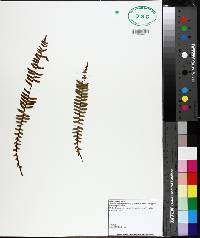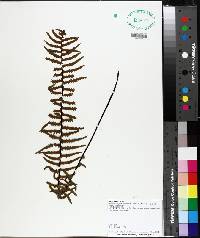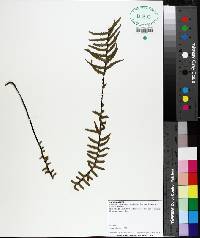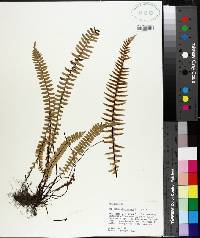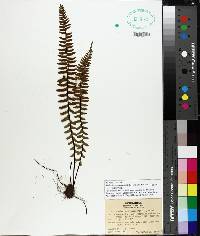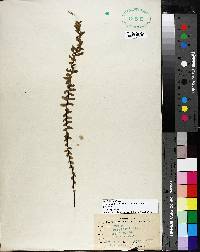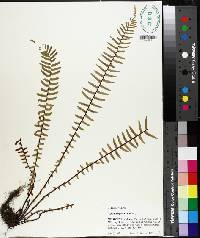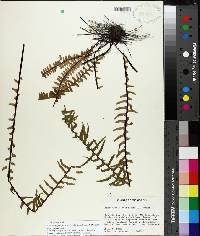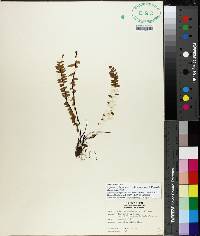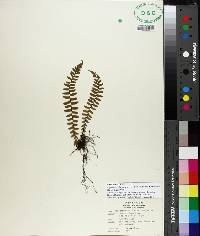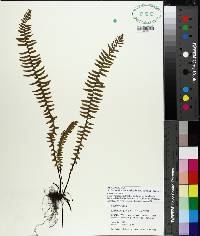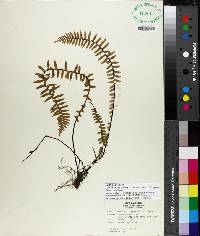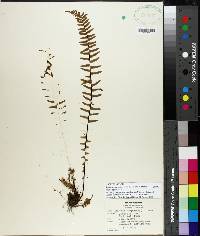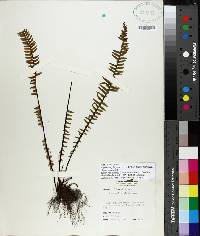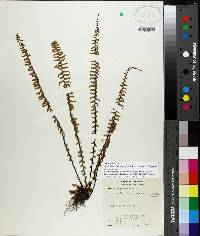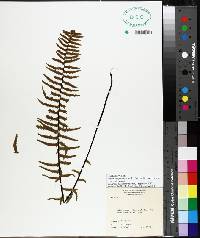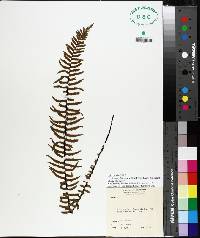Asplenium platyneuron
|
|
|
|
Family: Aspleniaceae
Ebony Spleenwort
[Acrostichum platyneuron L., moreAsplenium ebeneum , Asplenium ebeneum var. hortonae Davenp., Asplenium platyneuron f. dissectum J. E. Benedict, Asplenium platyneuron f. furcatum Clute, Asplenium platyneuron f. hortonae (Davenp.) L.B.Sm., Asplenium platyneuron f. serratum (E.S.Mill.) Ralph Hoffm., Asplenium platyneuron var. euroaustrinum Fernald, Asplenium platyneuron var. proliferum (D.C. Eaton) Tanger, Asplenium platyneuron var. serratum (E. S. Mill.) Britton, Sterns & Poggenb.] |
Roots not proliferous. Stems short-creeping, unbranched; scales dark brown to black throughout, narrowly linear-deltate, 2--4 × 0.3--0.6 mm, margins entire. Leaves ± dimorphic; fertile leaves taller and more erect than sterile leaves. Petiole reddish brown throughout, lustrous, 1--10 cm, 1/4--1/3 length of blade; indument of dark brown to black, filiform scales at base. Blade lustrous, linear to narrowly oblanceolate, 1-pinnate throughout, 4--50 × 2--5(--7) cm, thin, glabrous, or occasionally sparsely pubescent; base gradually tapered; apex acute, not rooting. Rachis reddish or purplish brown throughout, lustrous, glabrous. Pinnae in 15--45 pairs, oblong to quadrangular; medial pinnae 1--2.5 × 0.3--0.5 cm; base with conspicuous acroscopic and sometimes basiscopic auricle, this overlapping rachis; margins crenate to serrulate, sometimes more deeply incised in robust specimens; apex acute to obtuse. Veins free, evident. Sori 1--12 pairs per pinna, on both basiscopic and acroscopic sides. Spores 64 per sporangium. 2 n = 72. Forest floor or on rocks, often invading masonry and disturbed soils; 0--1300 m; Ont., Que.; Ala., Ark., Ariz., Colo., Conn., Del., D.C., Fla., Ga., Ill., Ind., Iowa, Kans., Ky., La., Maine, Md., Mass., Mich., Minn., Miss., Mo., Nebr., N.H., N.Mex., N.J., N.Y., N.C., Ohio, Okla., Pa., R.I., S.C., Tenn., Tex., Vt., Va., W.Va., Wis.; s Africa. The combining author for Asplenium platyneuron is often given as Oakes ex D. C. Eaton; see D. B. Lellinger (1981) for justification of the authorship employed here. Asplenium platyneuron is remarkable in that it occurs in southern Africa as well as in North America. No other North American fern has this distribution. Asplenium platyneuron is an ecological generalist and is particularly characteristic of disturbed woodlands. This species is migrating northward on the northern portions of its range in the upper Great Lake states (W. H. Wagner Jr. and D. M. Johnson 1981). Proliferous buds on the lowest pinnae allow formation of clumps with stems at several layers in the litter. Asplenium platyneuron hybridizes with A . rhizophyllum , A . trichomanes (producing A . × virginicum Maxon), A . pinnatifidum , A . ruta-muraria (producing A . × morganii W. H. Wagner & F. S. Wagner), A . bradleyi , and A . montanum (producing sterile A . bradleyi ).
Perennial fern 5 - 60 cm tall Leaves: several, clustered, stalked, green with reddish or dark brown midrib (rachis), lustrous, thin, hairless or sparsely hairy, pinnately compound, but linear to narrowly inversely lance-shaped in outline with tapered base and pointed tip. The leaves are of two different types: fertile leaves, which are more erect, 4 - 50 cm long, and 2 - 7 cm wide; and sterile leaves, which are spreading and shorter (5 - 10 cm long). Rhizome: short-creeping, unbranched, usually under 5 cm long, 2 - 3.5 mm thick, and covered with black or dark brown, 2 - 4 mm long, 0.3 - 0.6 mm wide, narrowly triangular to linear scales. Leaf stalks: dark brown to reddish brown, lustrous, 1 - 10 cm long, with dark brown to black, threadlike scales at base. Spores: 64 per sac, all of one kind, tiny, single-sectioned (monolete), and single-chambered. The spores give rise to the gametophyte (the sexual phase of the plant), which is tiny, green, and heart-shaped. Similar species: Asplenium platyneuron is similar to our only other member of the genus in the area, A. rhizophyllum, but that species is very different since it has simple, unlobed leaves that often root at the leaf tips, and it is restricted to limestone areas. A more similar species, A. ebenoides, has not been reported in the Chicago Region, but is a hybrid between A. platyneuron and A. rhizophyllum. It differs from A. platyneuron by having only pinnately-lobed leaves, which may be pinnately compound only in the basal third, and the leaf midrib is not as dark and usually turns green near the tip. Habitat and ecology: Occasional, usually in slightly acidic conditions, often in somewhat sandy woodlands, rich woods, or steep banks that have seeps, including along roadsides. Occurence in the Chicago region: native Notes: Asplenium is the only genus in the Aspleniaceae family, but there are about 700 species, with about thirty in North America, and many hybrids. Asplenium platyneuron has a very odd distribution since it occurs in both North America and southern Africa. This species hybridizes with several other species of Asplenium, including A. rhizophyllum. Author: The Field Museum Rhizome 2-3.5 mm thick, the few linear-subulate black scales 2.5-4 mm; lvs subdimorphic, 5-50 cm, with dark brown petiole and rachis; sterile blades spreading, 5-10 cm, very shortly petiolate, pinnate, with 15-22 pairs of sessile, alternate, crowded, oblong pinnae 7-10 נ3.5-4.5 mm, these rounded and remotely serrulate, tending to be auriculate at the upper base; fertile lvs few, erect, to 4.5 dm נ6 cm, short-petiolate, the blade linear-oblong, acute, narrowed basally, pinnate, the 30-50 pairs of alternate pinnae less crowded, more linear-oblong (except the reduced, more deltoid lowermost ones), to 3.5 cm נ6 mm, more prominently auriculate at the upper base and sometimes at the lower base as well, mostly serrate, seldom more deeply cleft; 2n=72. Woods, banks, and rocks in circumneutral soil; Que. and Ont. to se. Minn., Kans., and Colo., s. to Fla., Tex., and Ariz. Gleason, Henry A. & Cronquist, Arthur J. 1991. Manual of vascular plants of northeastern United States and adjacent Canada. lxxv + 910 pp. ©The New York Botanical Garden. All rights reserved. Used by permission. From Flora of Indiana (1940) by Charles C. Deam Infrequent in the southern half of the state where it is restricted to the unglaciated and sandstone areas. It probably reaches its greatest size on shady slopes of some of the loess banks of the southwestern counties. In the northern half of the state it is either absent or restricted again to the soils of sandstone outcrops and to the sand areas about Lake Michigan where it is only local. I have never seen it except in slightly acid soil, and when transplanted into an alkaline environment, even with great care and in a half bushel of the soil in which it grew, it gradually disappeared in a few years. [Variety serratum] is a form with some of the pinnae more or less deeply and irregularly serrate. I think this is merely a nutritional form. A fine example of this form was found in Perry County by R. M. Tryon, Jr. ...... Indiana Coefficient of Conservatism: C = 3 Wetland Indicator Status: FACU |


